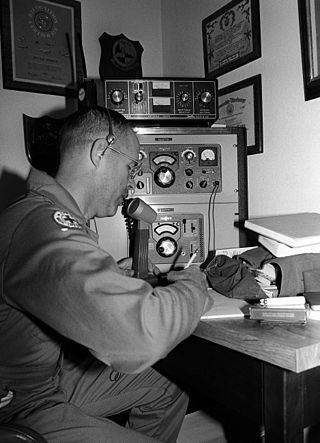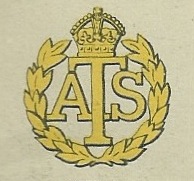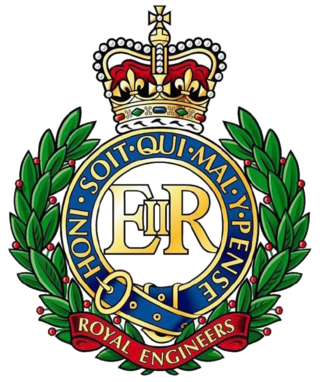
There have been two formations named British Army of the Rhine (BAOR). Both were originally occupation forces in Germany, one after the First World War and the other after the Second World War. Both formations had areas of responsibility located around the German section of the River Rhine.

I Corps was an army corps in existence as an active formation in the British Army for most of the 80 years from its creation in the First World War until the end of the Cold War, longer than any other corps. It had a short-lived precursor during the Waterloo Campaign.

Military police (MP) are law enforcement agencies connected with, or part of, the military of a state. In wartime operations, the military police may support the main fighting force with force protection, convoy security, screening, rear reconnaissance, logistic traffic management, counterinsurgency, and detainee handling.

The Royal Military Police (RMP) is the corps of the British Army responsible for the policing of army service personnel, and for providing a military police presence both in the UK and while service personnel are deployed overseas on operations and exercises. Members of the RMP are often known as 'Redcaps' because of the scarlet covers on their peaked caps and scarlet coloured berets.

The Royal Corps of Transport (RCT) was a British Army Corps established to manage all matters in relation to the transport of men and material for the Army and the wider Defence community. It was formed in 1965 and disbanded in 1993; its units and trades were amalgamated into the Royal Logistic Corps. The Depot and Training Regiment RCT was at the former Buller Barracks in Aldershot garrison.

Auxiliaries are support personnel that assist the military or police but are organised differently from regular forces. Auxiliary may be military volunteers undertaking support functions or performing certain duties such as garrison troops, usually on a part-time basis. Unlike a military reserve force, an auxiliary force does not necessarily have the same degree of training or ranking structure as regular soldiers, and it may or may not be integrated into a fighting force. Some auxiliaries, however, are militias composed of former active duty military personnel and actually have better training and combat experience than their regular counterparts.

The Auxiliary Territorial Service was the women's branch of the British Army during the Second World War. It was formed on 9 September 1938, initially as a women's voluntary service, and existed until 1 February 1949, when it was merged into the Women's Royal Army Corps.

The Royal Pioneer Corps was a British Army combatant corps used for light engineering tasks. It was formed in 1939, and amalgamated into the Royal Logistic Corps in 1993. Pioneer units performed a wide variety of tasks in all theatres of war, including full infantry, mine clearance, guarding bases, laying prefabricated track on beaches, and effecting various logistical operations. With the Royal Engineers they constructed airfields and roads and erected bridges; they constructed the Mulberry Harbour and laid the Pipe Line Under the Ocean (PLUTO).

The Berlin Infantry Brigade was a British Army brigade-sized garrison based in West Berlin during the Cold War. After the end of World War II, under the conditions of the Yalta and Potsdam agreements, the Allied forces occupied West Berlin. This occupation lasted throughout the Cold War. The French Army also had units in Berlin, called the French Forces in Berlin and the US Army's unit in Berlin was the Berlin Brigade.

The Royal Hungarian Army was the name given to the land forces of the Kingdom of Hungary in the period from 1922 to 1945. Its name was inherited from the Royal Hungarian Honvéd which went under the same Hungarian title of Magyar Királyi Honvédség from 1867 to 1918. Initially restricted by the Treaty of Trianon to 35,000 men, the army was steadily upgraded during the 1930s and fought on the side of the Axis powers in the Second World War.
Bergen-Hohne Garrison was a major British garrison in the post-Cold War period, with facilities located close to Bergen at Lager Hohne, at Lager Oerbke near Fallingbostel and at Celle in Lower Saxony, Germany. It was home to 7th Armoured Brigade and most of its subordinate units. It formed a major part of British Forces Germany.
The Germany Guard Service (GGS) is a British Ministry of Defence security organisation that provides armed security to the British Armed Forces, in Germany.

The 117th Infantry Brigade Royal Marines was an infantry brigade formation of the Royal Marines created in the final stages of the Second World War.
The following is a hierarchical outline for the structure of the British Army in 1989. The most authoritative source for this type of information available is Ministry of Defence, Master Order of Battle, and United Kingdom Land Forces, HQ UKLF, UKLF ORBAT Review Action Plan, HQ UKLF, 1990.
8 Regiment RLC was a regiment of the British Army's Royal Logistic Corps.

The 12th Signal Brigade, later 12th Signal Group was a military communications formation of the British Army commanding regiments of the Royal Corps of Signals. Initially formed in 1967, the brigade would provide rear defence communications for the British Army of the Rhine until its disbandment in 1992. In 2004, the group was reformed to provide territorial army and rear support to the Allied Rapid Reaction Corps in Germany. However, in 2009 the group was disbanded following reductions to the Royal Corps of Signals and Territorial Army.
13 Signal Regiment is a signal regiment of the Royal Corps of Signals within the British Army.

The 1st Field Engineer Squadron is an engineer unit of the Corps of Royal Engineers within the British Army. The squadron was first formed in 1914 following the mobilisation of the Army for the First World War. The squadron later supported The Cavalry Division and the first British Army of the Rhine. The squadron later saw service in the Second World War and today supports the 21st Engineer Regiment of the new 1st Strike Brigade.

The 1st Reconnaissance Brigade was a short-lived specialist formation of the British Army which administered the formation reconnaissance regiments not attached to a division or brigade, and was disbanded sometime between 2005 and 2006.
The 2nd Division Transport Regiment was a military support unit of the British Army, forming part of the Royal Corps of Transport. Initially formed in 1953, the regiment would serve the 2nd Infantry Division until its first disbandment in 1984 following a reorganisation of the British Army of the Rhine. Reformed one year later, it would finally be disbanded in 1993 following the End of the Cold War.













